It had been raining now for days in Delta Junction, and I felt that we might be close to wearing out our welcome at the Delta Public Library and at the coffee lounge at the IGA food market, if for nothing else than for simply being; loitering as it were. I figured the troopers would show at any moment to arrest us for vagrancy. Of course that is just me being sarcastic, as Alaska in general, and this part of Alaska specifically is certainly a place where one can do as they please without vexation from others. Folks here respect individuality and personal rights and property. In fact, we had been camped along the Delta River on the outskirts of town for a long spell now. Our tents and some belongings left there daily as we meander around town and take up space at the library. This practice has resulted in absolutely zero harassment, theft, damage, or chaos of any kind. One of the many, many reasons I am proud to call Alaska my home. Some years back I had been camped on this same river beach on a long bicycle journey, and as I eat my lunch and listen to the rippling river, gun shots are heard alarmingly close. I look back toward the tree line at rivers edge and see a man leaned across the hood of his truck, pistol in hand and firing again. This time a great cloud of dust and debris explode not 20 feet from my position and I realize that either his is shooting at me (and is a terrible aim), or he is not shooting at me but does not see me. I assume the latter and scream at him. He looks more surprised than I do and screams back a shaken apology and gets in his trucks and skedaddles fast. Another time on this same beach, on yet another long bicycle journey, I had lost an envelope containing some 4000 dollars in cash. No shit… not stolen… lost. This beach has always been a strange yet somehow beckoning place to me… I simply can’t explain it, but I always like camping here when I am in the area. We had been killing time here for several days and except for a jaunt up Donnelly Dome during a brief, hours long lull in the storm, we had become a fixture in this tiny Alaskan town. The foray up Donnelly was a pleasant and rewarding surprise: as soon we pull into the parking area off the dirt road south of Delta about 20 miles, a massive Bull Moose trots past us, not 30 feet away and paying not the slightest bit of attention to either Dennis nor I and our dropped and gaping jaws. Donnelly’s summit, a mere 2500 feet above the surrounding tundra sports some arresting views of the countryside below, and were it not stormy, I’m sure the views of the Alaska Range some 40 miles to the south would have been nothing short of incredibly spectacular. At the summit, a Marmot skull sits upon a small stone, as if to peer southward to the omnipotent Alaska Range. Was it an omen? Was the creature’s skull a sign of imminent death in those magnificent mountains. I thought not and held the little critter’s head piece in my hand for a bit before setting it back down and retreating to the truck. Later in Delta, a weather report brings a light ray of hope in our little world and we hit the sack and prep for another mountain adventure to the south.
In the morning, I awake to a stillness and warmth that has been absent these last days; I peer from my tent to see a crystalline sky of deep blue and a calm that follows it. Walking out onto the beach, the central range has a clarity to it not seen yet on this trip: the massive peaks of Mt Hayes, Shand, Moffit, Balchen, and Deborah rise from the tundra with intent and sharpness, with not a wisp of mist or cloud surrounding their stature. The summits and ridges are sharp and full of contrast and color. This is a rare sight in these parts and I shout to Dennis in his tent of the spectacle. Soon we are up, packed, and off to our favorite diner for a celebratory omelette and endless cups of coffee. After a relaxing breakfast, there is nothin left to do but to begin the hour drive south on the Richardson Highway to the little 4WD dirt road I had discovered weeks earlier and the beginning of our hike onto the Castner Glacier and our goal deep within these mysterious mountains. We gas up and head south. On the drive down, a tourist has stopped at the bottom of a long full speed hill with a long lens poking from the vehicle’s window, shooting photos of a Moose foraging in a roadside pond. He is stopped squarely in the middle of the road in a high speed section and I pass doing 60 leaning on the horn. Soon we are at the dirt road, and the Toyota crawling along slowly, bouncing from rock to rock, emerges at the rough path and ends at the beginning of a faint game trail with the treacherous and thunderous Castner Creek roaring past with violence and intensity.
Our goal on this adventure is a peak known as the White Princess; a striking glaciated triangular peak of 9,800 feet, and one of the highest in the Delta Mountains. Descending from the summit of it’s 4000 foot west face are two distinct ridges, the Northwest Ridge and the Southwest Ridge. Our goal of the Northwest Ridge sits above a fork of the Castner Glacier called the M’Ladies fork, called so due to it’s origins from the cirque below the neighboring M’Ladies Mountain. After studying the maps purchased from the UAF in Fairbanks, and after reading scant accounts on the internet, it appears that our goal is to head up the Castner for about 8 miles to where the Castner splits into three separate forks, all leading to different cirques and several different peaks. From the fork in the glacier, another three or so miles up the M’Ladies Branch will take us to the base of our route. The first mile is flat and pleasant and meanders the Castner Creek corridor to the toe of the glacier, where a massive ice cave penetrates the snout of the beast and from it spits out the raging river beside us. A short scramble up the scree and mud to it’s left brings us to the top of the moraine and the debris covered serpent we will be traveling for many miles ahead.
After breaking through the Alder thicket near the top of the moraine, we are greeted with a sobering sight. Now, I am no stranger to traveling upon debris covered glaciers, full of scree, talus, medial moraines, crevasses, and moulins, but what lay ahead was another matter all together. For as far as the eye could see, all the way back to the M’Ladies Branch, lie what can only be described as an endless field of unstable talus, mud, Alder thickets, and boulders. I have never seen a glacier so entombed in such a disastrous array of debris and ankle busting madness… for miles. It becomes clear that the Castner is a big, dying glacier that has become entrenched in more chaos than I thought possible. All accounts I had read were all done in the earlier months; meaning most trips into this region have been done on skiis, allowing relatively sane passage along this corridor and into the high cirques, but we were here in July. The thought of endless mile after mile of this sort of blistering travel filled me with dread. However, what must be done must be done, and the beginnings of a very long day of tedious route finding, side hilling loose scree, and heinous bushwhacking through Alder and Willow thickets ensues. After navigating the initial moraine and figuring out a path of least resistance, we emerge on the far right side of the glacier/moraine where dense thickets are growing. Off to the right of these thickets, steep mud slopes lead far below to the emerging ice and it is at this delicate spine that we must adhere to in order to make this trek feasible. Hours of meandering the Willows and mud fields brings us to more open areas where the glacier is obviously now just below the surface of this undulating and heaving mass of mud, Willows, and scree. A small ridge is gained and we stick to it’s intent; the sides of which peel off to both sides to ice caves and mud fields. Eventually we come to where we are high enough on the glacier to where it is now simply a matter of traveling monotonous talus and it feels a welcome relief. Miles from the truck, and hours later, we emerge at the fork in the glacier, where we find exhaustion and fatigue taking it’s toll and decide to make a bivi.
Glacial moraines are not always the most forgiving places to sleep, resulting in some time spent clearing areas out for our bivi sacks by moving the razor sharp rocks and layering them appropriately into level and reasonably comfortable slumber platforms. Once this was accomplished, supper was prepared and we eagerly crawled into our sleeping bags just as the evening alpenglow engulfed the imposing North Face of M’Ladies Mountain and the un-named peaks to the south. It was a lovely sight for my eyes as I drifted into much needed sleep. I dream that night of Dall Sheep and glaciers…
The morning we sleep somewhat late since we are under no pressure to get going early, as the 3 miles of glacier travel in front of us to move our bivi to the base of the route should only take a few scant hours. This feels luxurious and after a relaxing breakfast, we are moving back onto the ice; the sky above filled with a mixture of blue and scattered clouds. The ice of the glacier crunching beneath our crampon-less boot soles and the swooshing of the many runnels of moulins flowing on the surface of the ice. Once in a while, one of these glacial rivers disappears into a “sink hole”, where the water travels to the bottom of the glacier to become a part of it’s ever growing subterranean river. Peering into these dark and bottomless holes is downright spooky; if one were to fall in, you would certainly be done for. Dennis suggests we set up a rope and rappel into one for photographic and filming purposes, but the thought of even entering one of these icy tombs frightens me endlessly. Being who I am, I feel always best when I am in the Alpine Zone, far above the tree line, high on a cliff, or on a mountain top. Tight places, caves, tunnels and whatnot have always been something I drastically avoid: my phobia of these places sometimes even invades my sleep. We continue up glacier and large boulders appear; marbled Schist ranging from a dull grey, to shining silver with great veins of quartz meandering through it, to swirls of bright orange and red, indicating there are a variety of minerals in these mountains.
Soon, we come to where we are looking directly up at the western arm of the Northwest Ridge of the Princess; between the bottom of the ridge and where we now stand are great cliffs of shattered rock and an enormous waterfall cranking past the entrance to the upper valley where another large, but dying glacier flows from the Princess’s massive, if crumbling and treacherous West face. A desperate looking scree slope rises to the north of these menacing obstacles perhaps 500 feet to where there is green tundra and small alpine meadows. This, I’m thinking will be a splendid spot for our new bivi. Upwards to the scree finds us both clamoring foolishly; two feet up, one foot back, until at the nasty looseness culminates into an apex of sorts where what seems like class 5 scree leads directly to the lush and welcoming tundra. After some time scouting and going up another level higher to the base of the ridge proper, we find some level tundra and a small stream for water and call this home. Early to bed for a 3 am alpine start is in order; the weather is continuing to improve and after lying there in my bag wide awake for several hours, the sky clears completely, and one of the finest displays of Alaska midnight alpenglow I have ever witnessed takes hold. The giant peaks of the Hayes Range thirty miles on the other side of the Delta River Valley are immersed into the pink glowing alpine madness; the West Face of the White Princess shows a magnificent transformation that earlier appeared hideous and grotesque, now exhibiting a beauty and elegance that emphasized it’s massive hanging glacier and heavily crevassed summit pyramid. M’Ladies Mountain is not left out of the grandness either, nor is Mt Silvertip, Mt Blackcap, Triangle Peaks, or any of the countless un-named peaks in this region. The sight is incredible, but only adds to my sleeplessness, as I am compelled to shoot photos till after 1 am… the alarm will sound in just two hours.
I drift to fitful sleep and what seemed a second later, the alarm goes off and I am up, shouting to Dennis at his bivi a couple hundred feet away that it is time to get a move on. After much time spent simply getting to a point where we can begin boiling water for tea and oatmeal, we finally do so and begin the trudge uphill beyond the tundra and into the seemingly endless talus towards the top of the lower ridge. It is already 4:30 am and it takes us another 2 hours just to reach the beginning of the exposed and treacherous looseness of the scree and mud knife edge that leads to one false summit after another.
Now one thing I know about alpine climbing is that in order to climb decent snow and ice, one must get out of camp at an extremely early hour. This means having one’s proverbial shit together for a lightning fast escape from camp after waking. For whatever reason, this did not happen on this morning and I felt we were on the route far later that to be desired; I knew the snow and ice conditions would be crap by the time we were upon them. Once to the ridge top, the sides dropped away to glaciers on either side; so steeply in fact that a fall here would be certain death under any circumstance. After each section, a small gendarme would have to be negotiated on one side or the other, and at other times, small summits would appear and endless loose talus would have to be climbed to go over it’s top, where we would then wistfully descend to yet another saddle, looking upwards toward yet another summit on the ridge. The last major summit to be climbed up and over was a big one and consisted of extremely loose scree and gained close to 900 feet of elevation, before descending it’s top and losing another 500. After this reluctant descent, we find ourselves deposited at the start of the ice and the first views into the hidden cirque containing the upper Castner Glacier, the NW Face of Blackcap, and a daunting set of sliver thin seracs clinging suspended like from the groaning and fractured ice below us. Directly underfoot lay the top of a great ice couloir; not far below it is a mighty bergshrund of epic proportions where darkness prevails just inside it’s frigid caverns. The couloir that lie below this fracture appears rock hard solid ice coated with a black film of sand and debris pitched back at an angle of about 70 degrees. Far below, perhaps 2000 feet, lay a field of steepening seracs and agonizing crevasses to reveal one of the more chaotic sections of glacier I had seen yet in this range.
Donning crampons and axes, we front point above the lower ridge line to where a crevasse must be negotiated and a traverse to the far left brings us to more open views of the airy cirque below. The exposure is greater here as well and once across the icy gap, we find the ridge flattens to a long and even stretch of neve and crevasses that are mostly easy to spot an avoid. Still unroped, we climb a steeper 45-50 degree bit of nice firm neve for about 300 feet which places us at the beginning of yet another long crevasse field. After probing into this area and finding holes, we decide to rope up and work our way across this crevassed plateau towards the rising and dominant summit pyramid. A great cornice sticks out from the summit and avalanche debris can be seen on the slopes below, perhaps 500 feet from the top. Off to the right, a serac that we could see clearly from our bivi has peeled away from the main body of the glacier and hangs precariously over the staunches of the west face, threatening to drop the entire 4000 feet at any give time, in fact this whole area to our right is a time bomb of falling seracs and ice. As we move further upwards and getting closer to the pyramid, the hanging tongue of the glacier can now be seen up close before spilling over the side and into the bowling alley chutes of the audibly disintegrating west face. We had both heard the ice falling from this tongue last night; it would come in waves… almost in perfect rhythm. A crash, then silence… repeat. As we enter the crevasse field, the neve gives way to deepening snow and crevasses that are not only skimmed over lightly making for dangerous conditions, but are hard to spot as well. After a spell, the summit block is near and Dennis expresses his concern with the route I had chosen to climb it via it’s more direct western side. I mention that if he thinks we should climb the longer and easier looking east side, then I am OK with that. I ask Dennis to lead the way and off into the worsening snow conditions we go, aiming for the east ridge and it’s juncture with the summit area. It was getting colder the higher we climbed, but it was late morning now and the intensity of the sun was incredible. The snow was softening and endless amounts of sunscreen and glacier cream had to be applied; sunglasses were adorned more sternly and as we trudged into the deepening snow, crevasses began to be a bit of an issue as my leg poked into one… then another. Dennis too was poking through to have a peek into the glacier from time to time. We neared the upper east ridge and soon I could see up it’s spine toward the summit; what now became obvious was that the east ridge was a corniced knife edge and would require much more care than had previously thought. In fact, the climbing looked dangerous and time consuming. I declared that we must return and instead of descending the treacherous crevasse field to re-join our original line, took the lead and began an arduous traverse across the base of the summit pyramid, working my way through the avalanche debris we had seen earlier. The conditions continued to worsen and now instead of merely being a nuisance from post holing, it was now what I would certainly call breakable crust. If you put your weight uopn the snow and stepped up, it would hold you for a half second before giving way and sending your leg deep within, sometimes all the way to one’s crotch. To alleviate this madness, I developed a technique twhere instead of hoping the crust would hold, I would forcibly thrust my foot through it and stomp the snow beneath to hold my weight; usually this was no more than 12”-16” below the surface. It was far better than giving mercy to the crust and the velocity of one’s weight depositing your foot 36” under. By the time we got across the avalanche debris, we were beginning to climb the lower slopes of the summit block. We were both working terribly hard and in between the sounds of my own gasping, I hear Dennis cussing wildly and damning this place all to hell. Tensions build between us and all I can think of to say is that this is all a part of mountaineering, and listening to the bitching is making it harder. I put it out of my mind and soon we are at the lip of a large crevasse creating a steeper pitch to the summit ridge. We stop to re-group and set up a belay where I lead up and over the final obstacle; suddenly there is no more going up and all sides around us peel off in every direction. To the north the summits of Blackcap and Old Snowy rise from the surrounding icefields, and beyond lie the endless tundra to the north. The Hayes group off to the west appear Himalayan in size and block all views of the western range including Denali herself. To the south and east, the magnificent icefields and serpents twist and wind down rarely seen corridors leading to rarely visited rivers and deep wilderness. The north faces of some of the visible peaks are nothing short of spectacular; there is a sea of ice before us. Most of these ice entombed peaks are un-named and rarely climbed and the sense of isolation here is somehow unexpected, yet glorious. These peaks of the Eastern Range are small compared to their western counterparts, but are ever omnipotent in their own right and absolutely command respect; this place, these peaks, the glaciers below us touch my heart in a way that makes me feel both very small, yet very big as my place on this planet reveals itself to be an important one and the unexplainable beauty of this place sinks into me so deeply it can never be extracted. I love Alaska and it’s mountain ranges, it’s animals and people, it’s wilderness, and endless possibilities. There is simply no other place like it.
After consuming calories and taking some photos, Dennis and I shake hands in celebration and descend the summit pyramid; the task is almost as difficult as the ascent was, but soon we are out of the treacherous snow conditions and happily cramponing somewhat firmer neve utilizing french technique and front pointing down the steeper sections to the ridge, where more crevasse negotiation takes place before we come to a place where 3000 feet of scree lead off the south side of the ridge to the glacier below. We opt for this alternate descent so that the endless gendarmes and false summits may be avoided all together, but this is an unknown route down, and I am a little apprehensive. After considering the alternative, I jump off the ridge and commit to the scree. After descending several hundred feet, I wave to Dennis and he commits to scree as well. Some of this stuff is small enough and loose enough that one can actually “ski” down it; boot soles kicking off tiny avalanches of ball bearing rocks and then attempting to stay on it’s surface. The technique works surprisingly well, and after about an hour, I am near the ice not far below. I wait for Dennis for a bit and when he arrives he says he wishes to traverse to a shelf off to the right as he believes it will lead back to our bivouac. I feel that descending to the glacier and stomping it’s length is a better alternative, so Dennis and I part ways for the remainder of the descent. Pretty soon, Dennis is out of sight and I am trudging along the muddy scattered surface of the glacier below the west face of the White Princess. Looking up, I see the littered path of the constant icefall heard the night before; the ice gullies and chutes a debris field for exploding ice chunks and rockfall, I figure it to be suicide to attempt to climb this face. In camp by 4:30 pm, I spot a mother Dall and her two babies on the edge of our bivi, but there is no sign of Dennis. I am too tired to eat and crawl into my sleeping bag and fall asleep almost instantly. Later, I awake to Dennis’ footsteps. We chat for a bit before he stumbles off to find his own sleeping bag to caress. Sometime later, I feel raindrops on my face and dig into my bivi sack deeper for cover. Sleep takes me completely and when I awake, it is 5 am and raining.
We decide that hanging out in our bivi sacks for the weather to improve sounded like a torturous idea; not only that, but my ankle injury from two years previous was flaring up; it was time to get out, but the thought of the death march back to the truck was daunting to say the very least. I downright dreaded it. The initial scree slopes from our bivi down to the glacier were painfully slow and detrimental to my ankle, but soon the glacier appears and we are making headway down to the fork. After 8 hours of battling this beast, I make it back to the truck. Dennis is somewhere behind me, and I decide to bath in the icy cold Castner Creek, make a sandwich, and take a nap. Two hours later, Dennis comes rolling in and we fire up the “Yota and head north for Delta, where more sandwiches, a six pack of beer, and a glorious sunset over the Alaska Range impresses upon us a time for relaxation and deep sleep. The next morning, we casually head back to Fairbanks, where Dennis’ previous foot injury and my ankle injury are needing rest. Dennis fly’s back to California a day or so later, and I rest up for more unknown solo adventure and begin to think about heading south a bit, for in another 10 days, I will be meeting Angela in the Yukon for a climb up Mt Archibald in the Kluane region… but that’s another story.




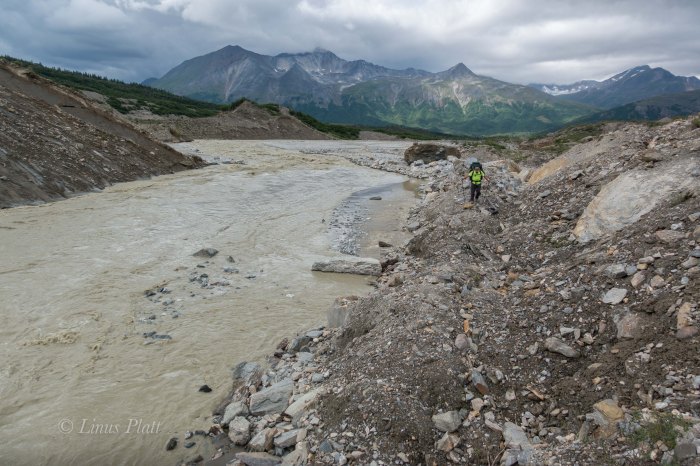

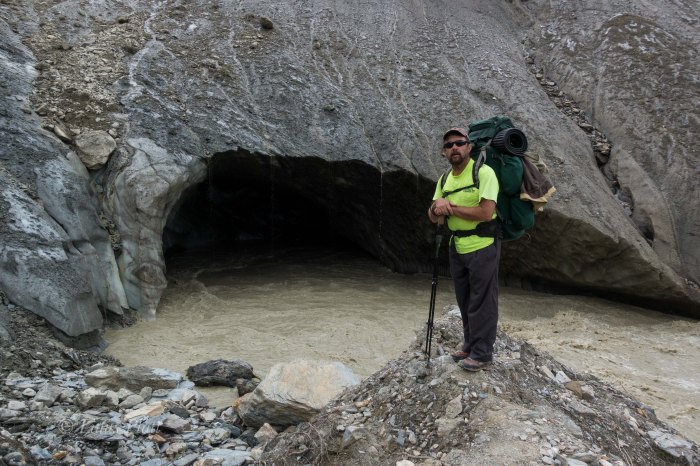
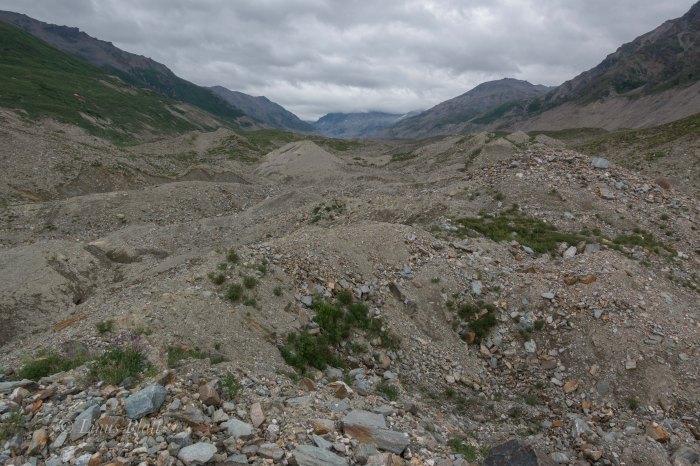




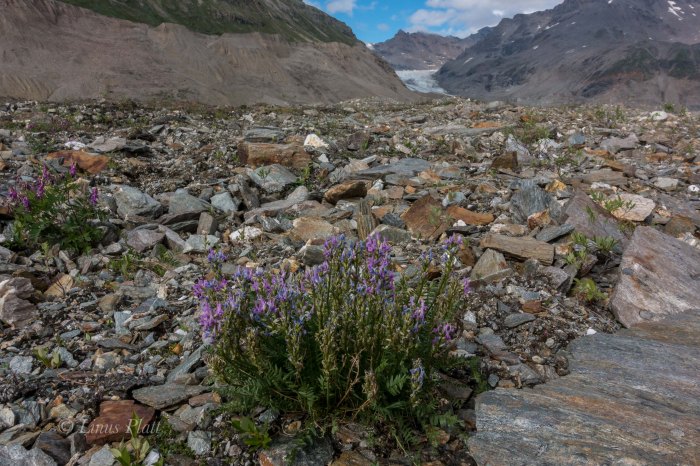



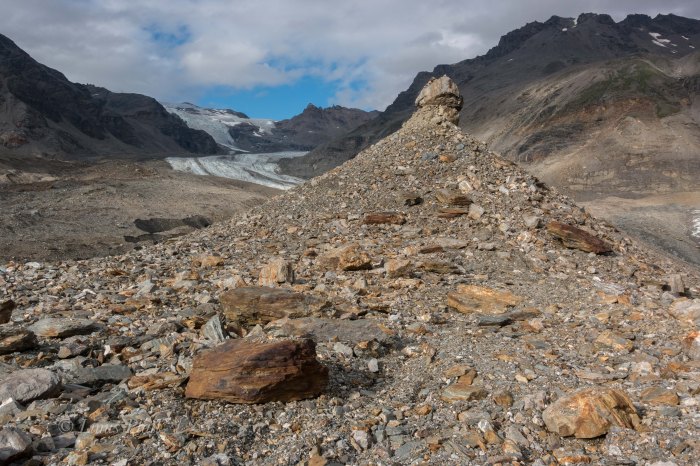



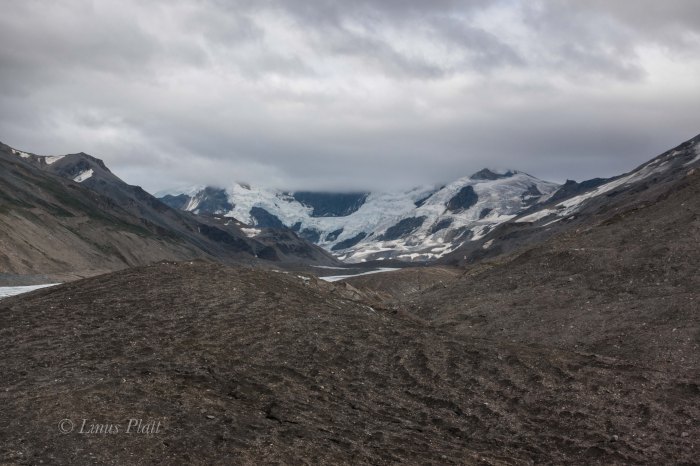

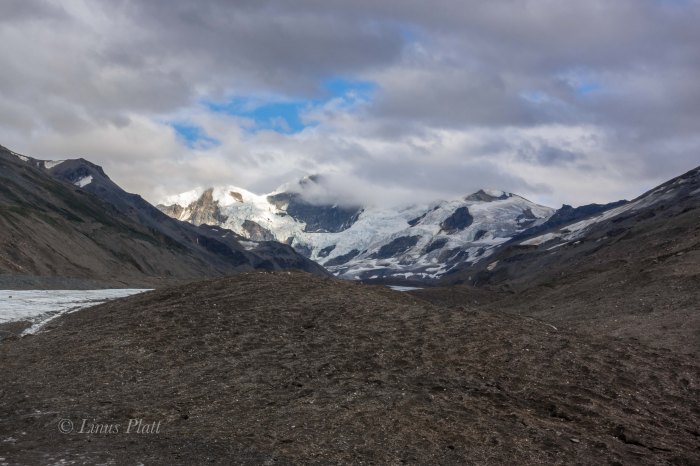






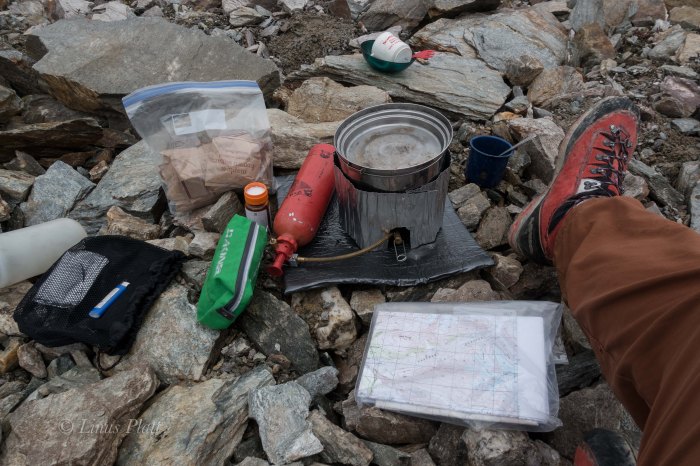






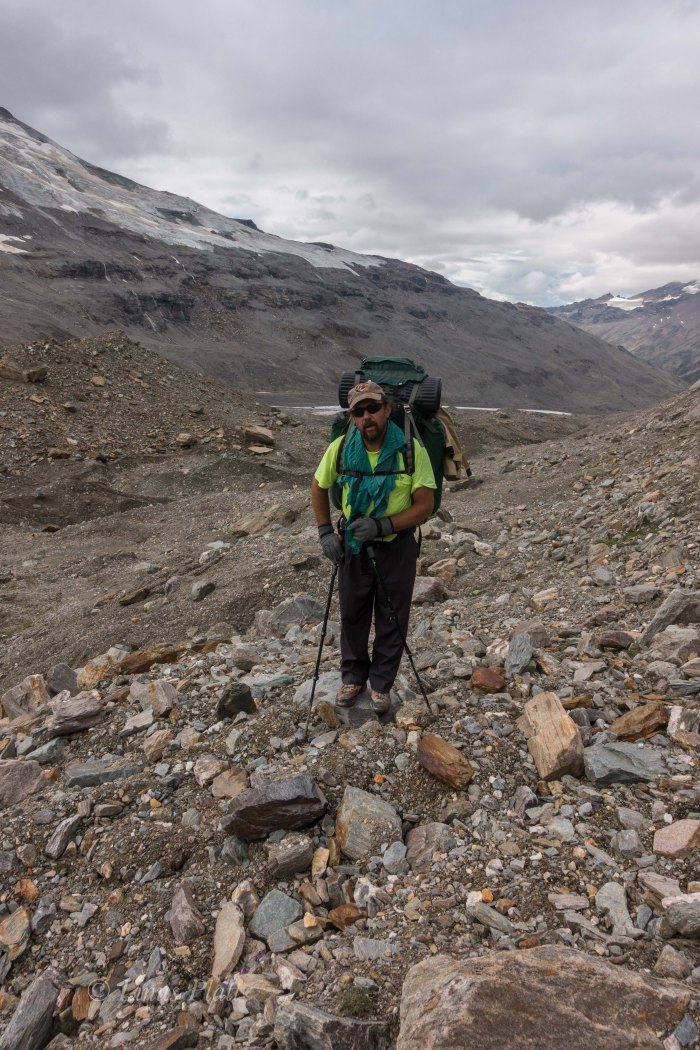






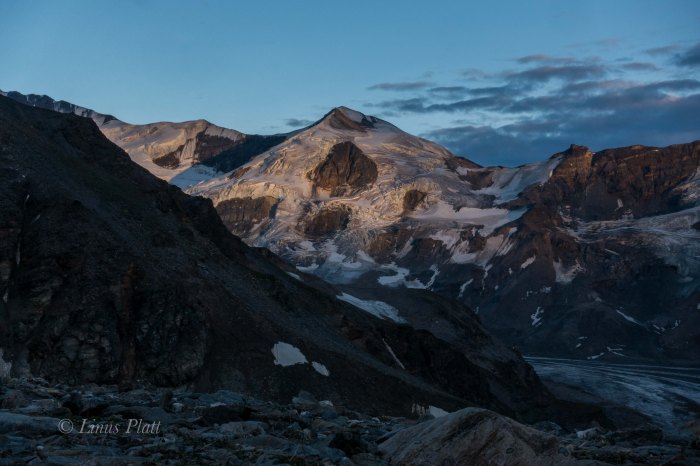

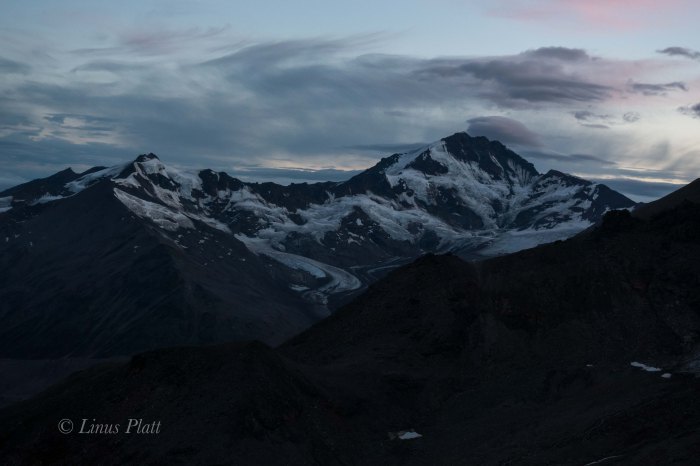


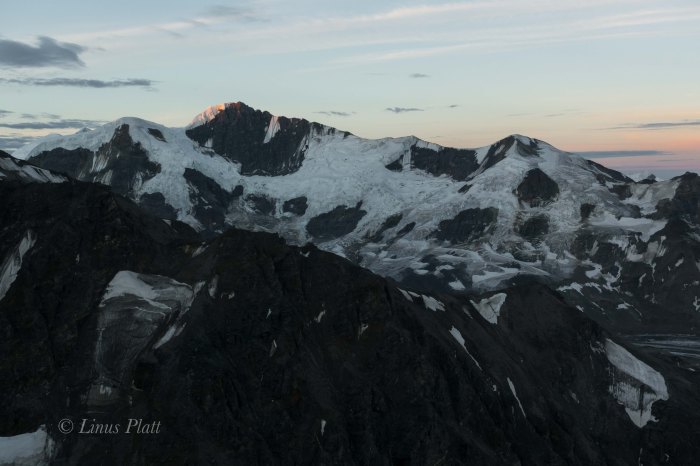
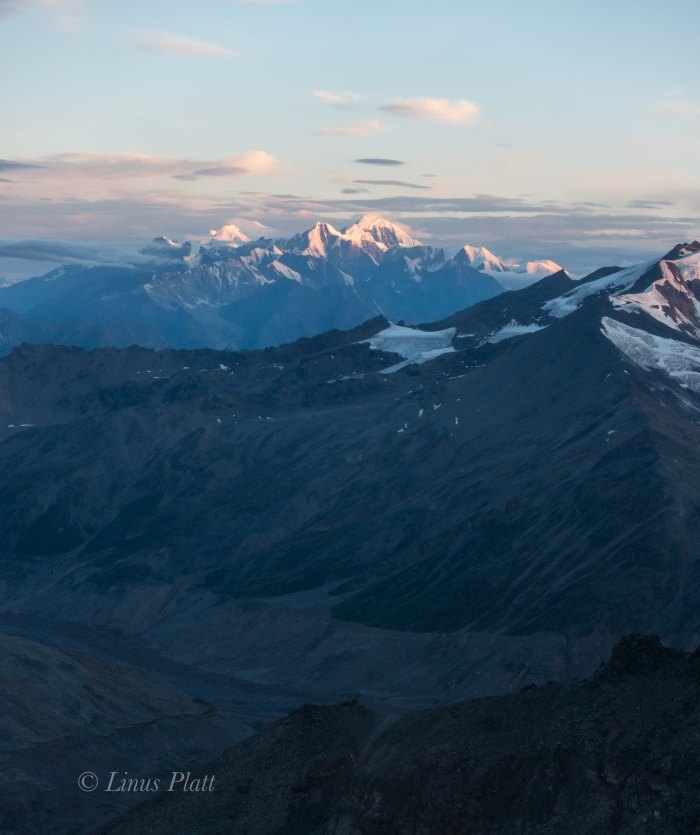
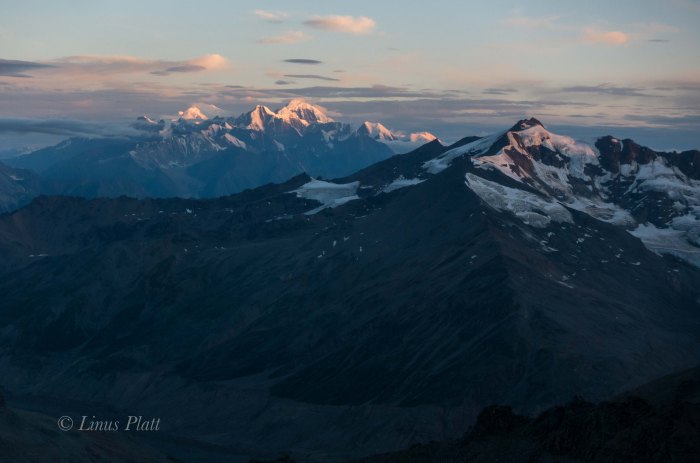

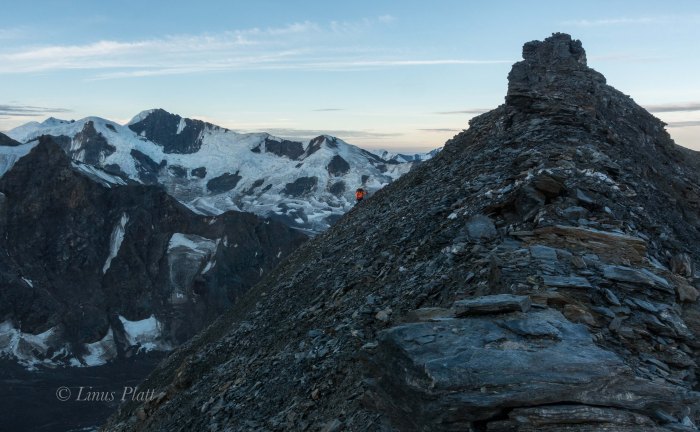







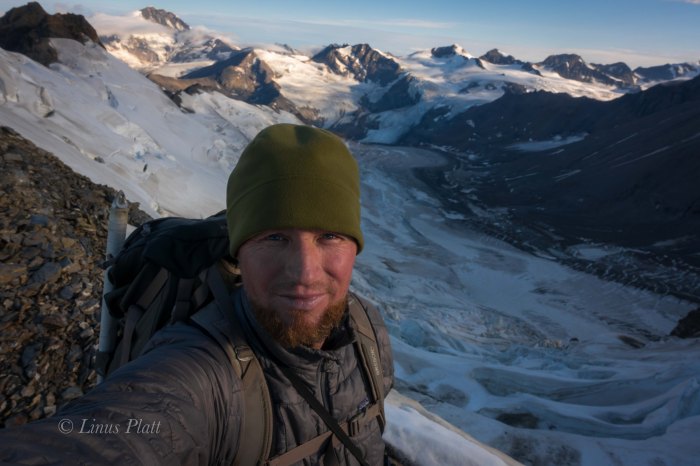
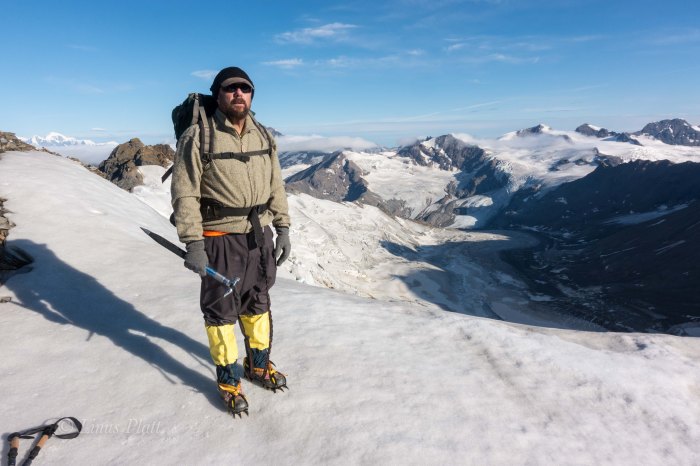








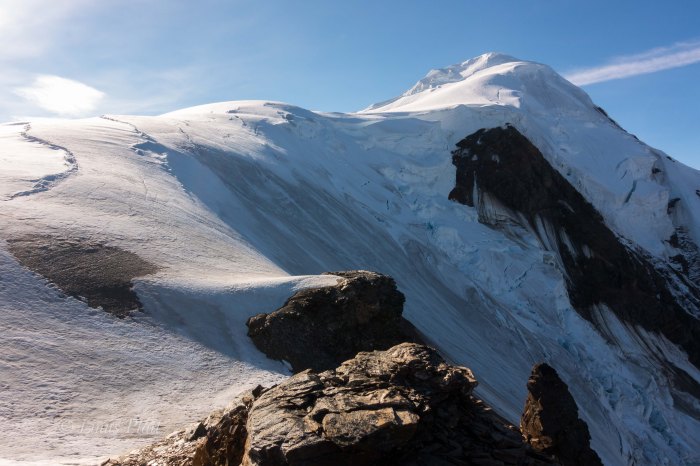
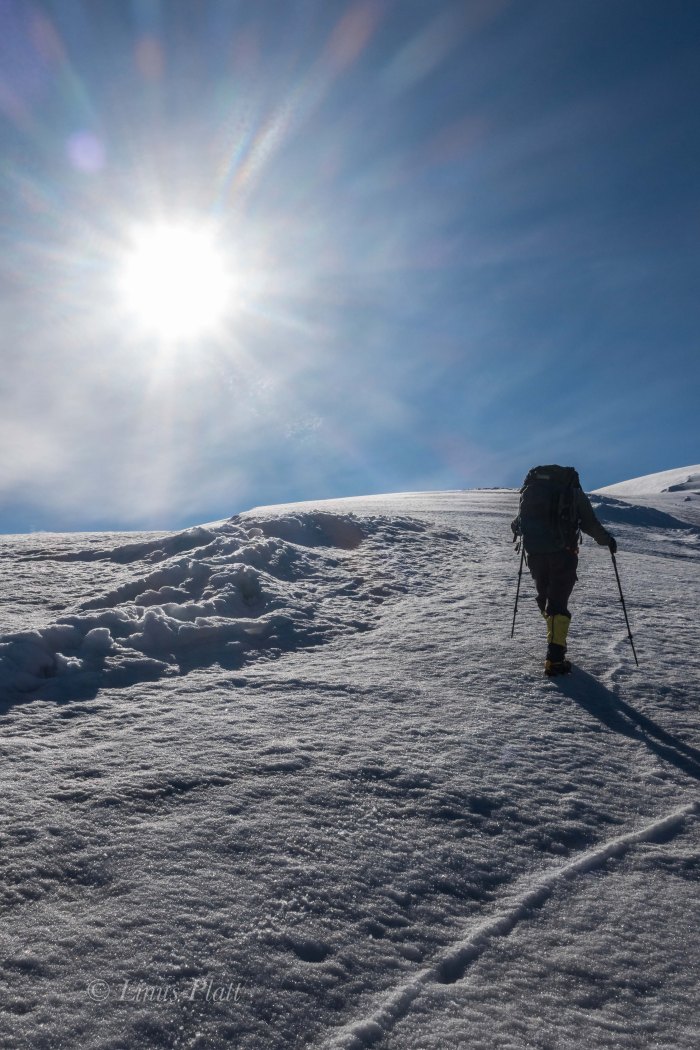


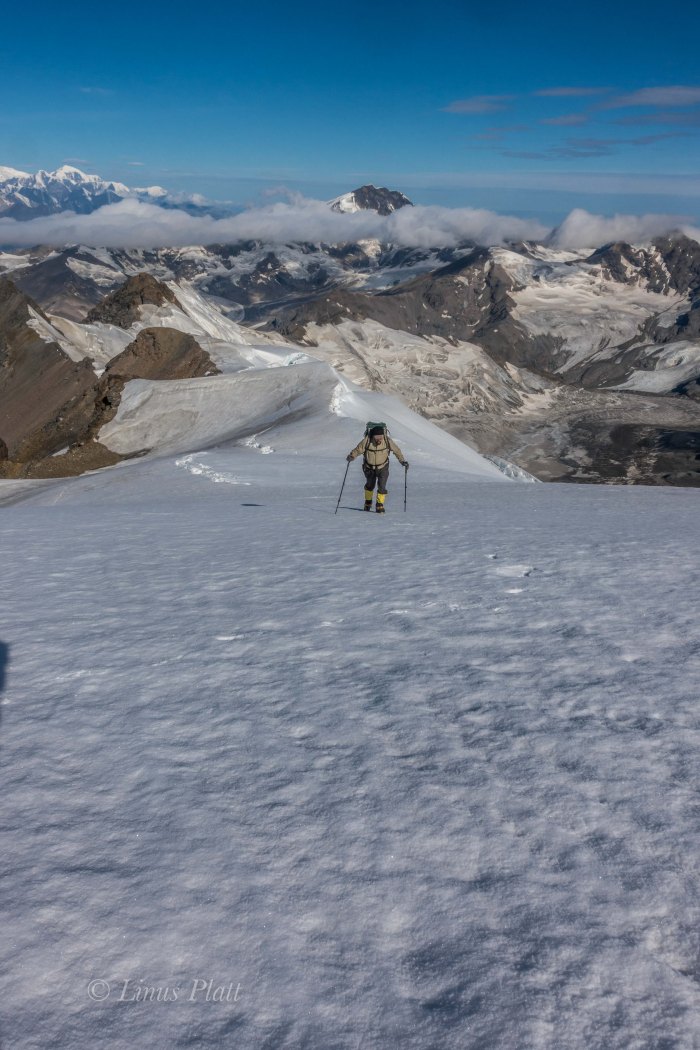





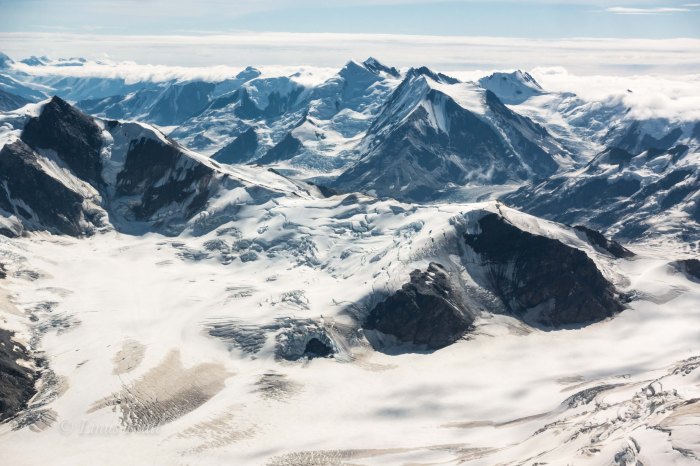








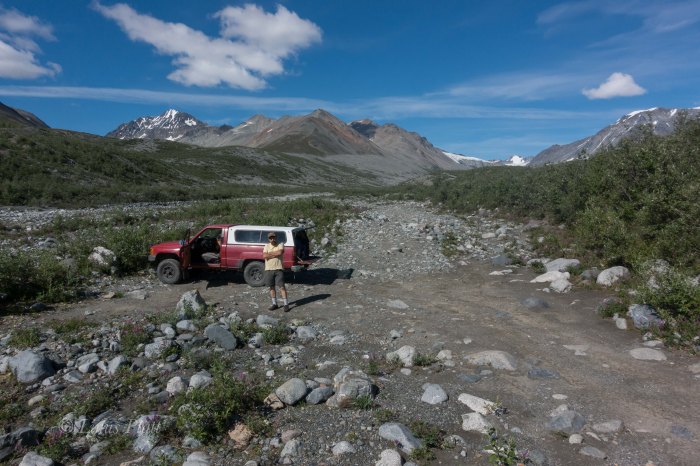

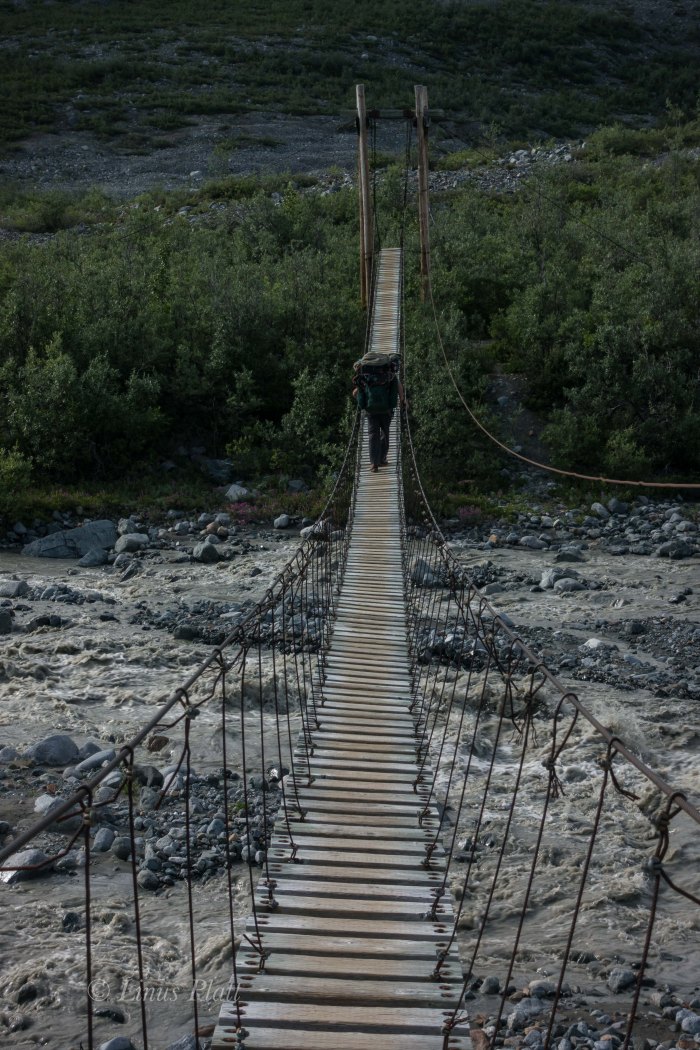

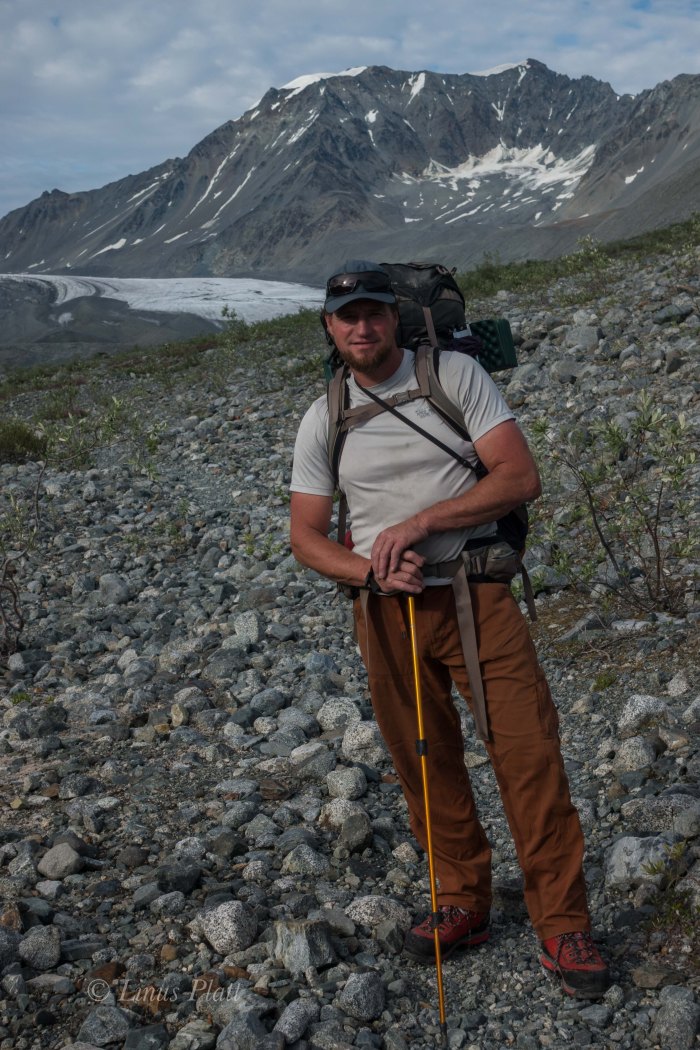


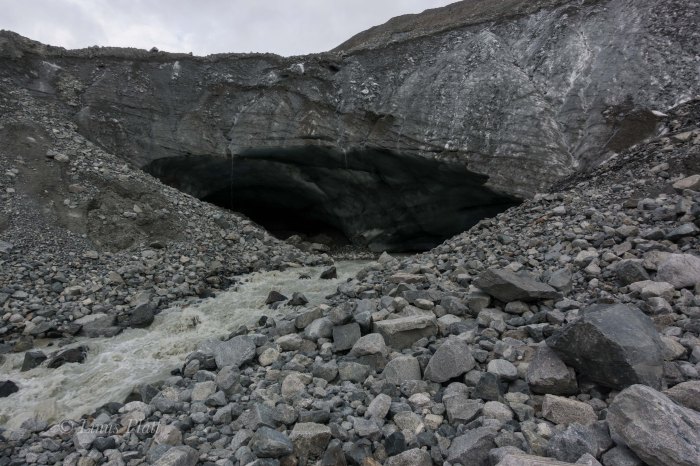





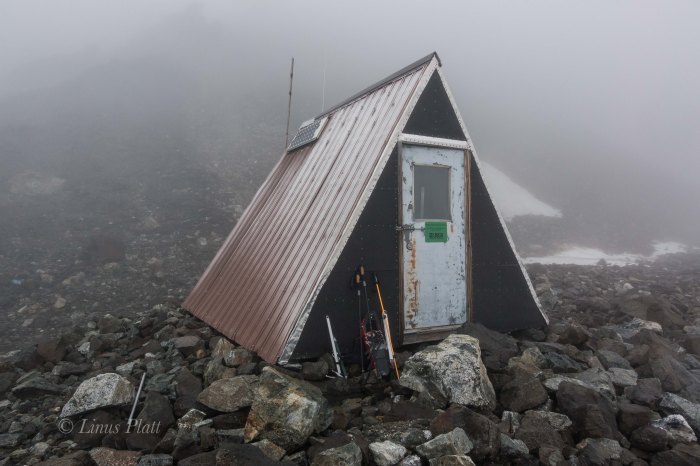






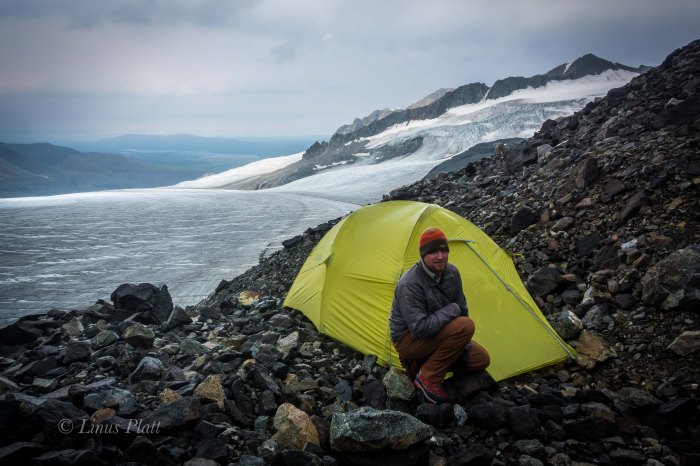



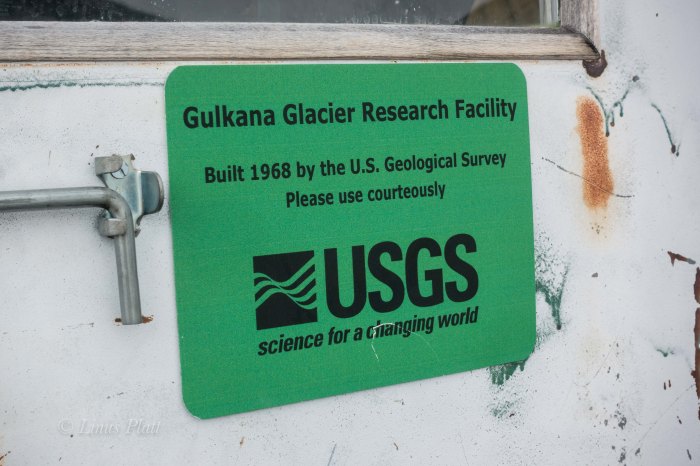
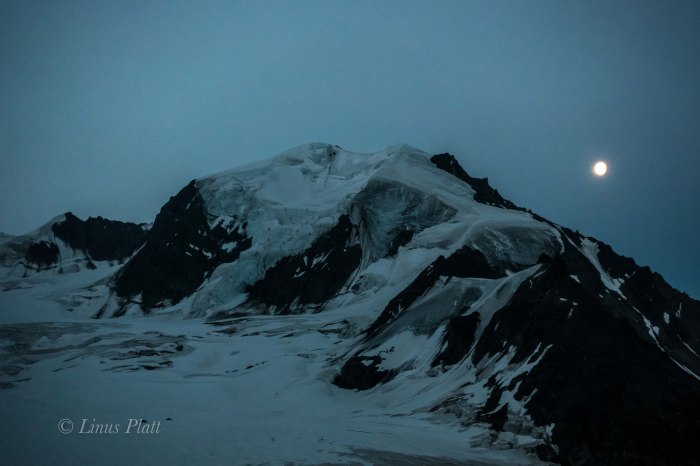
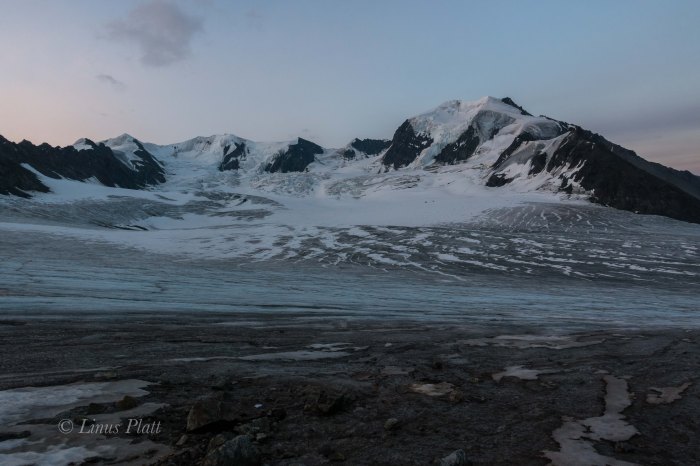

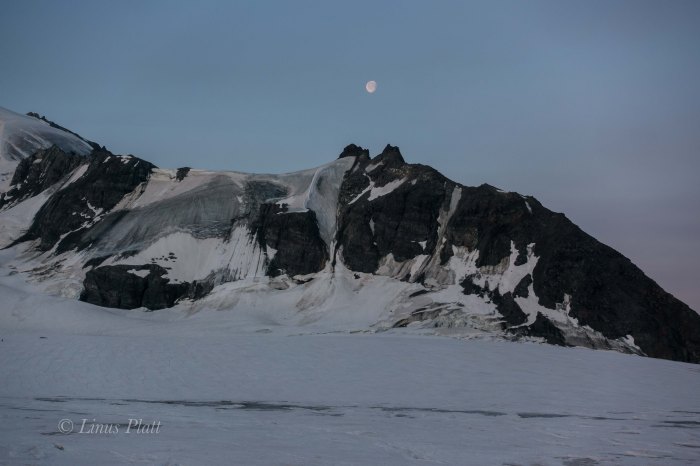


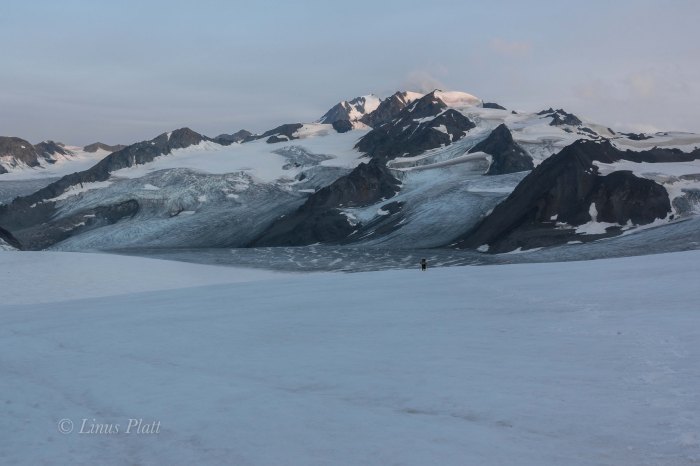







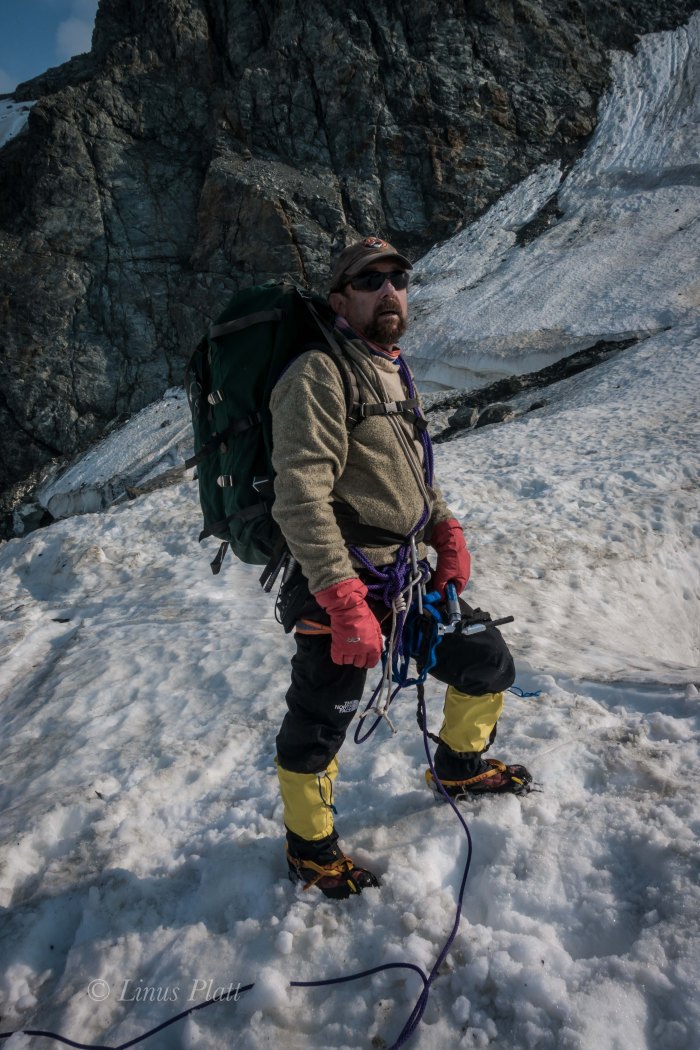



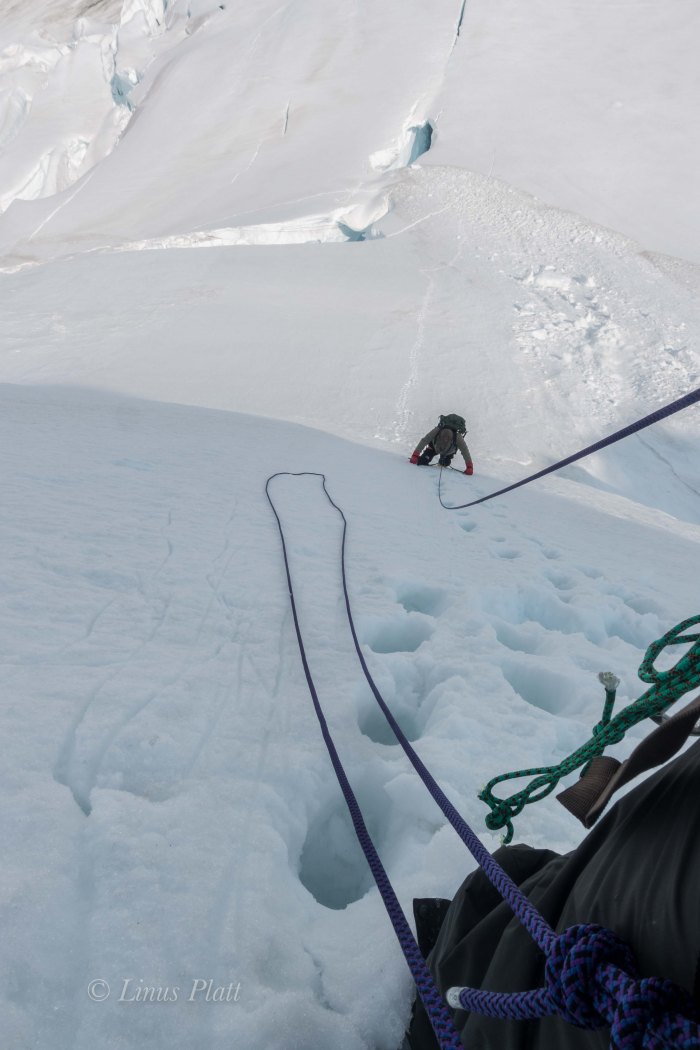

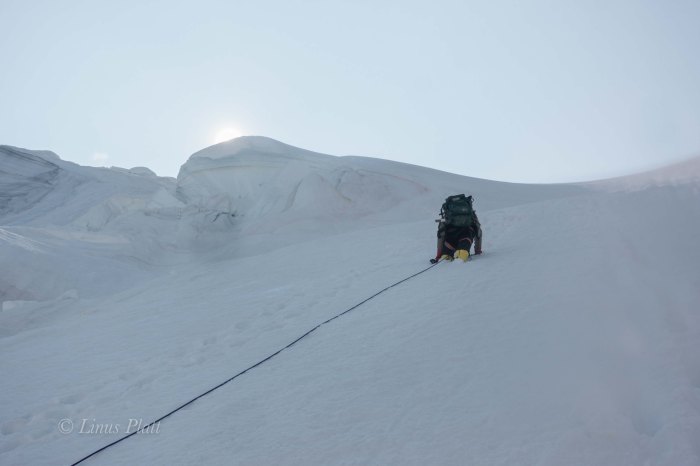
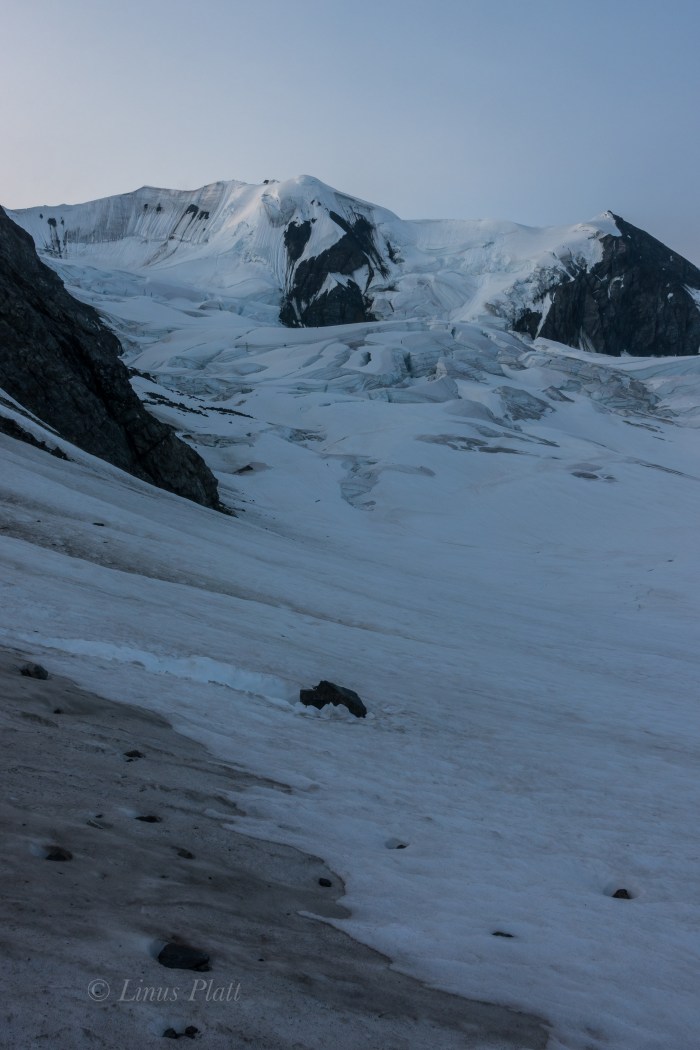
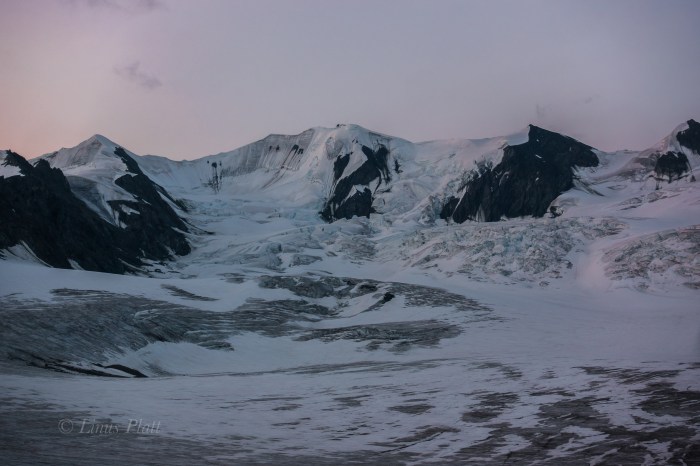

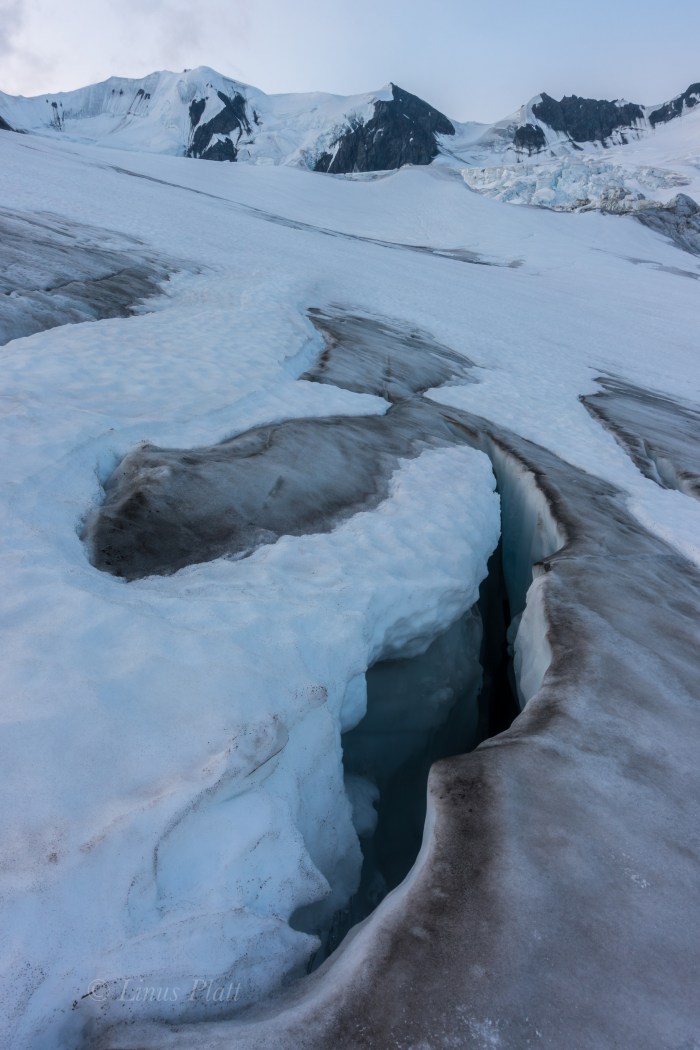
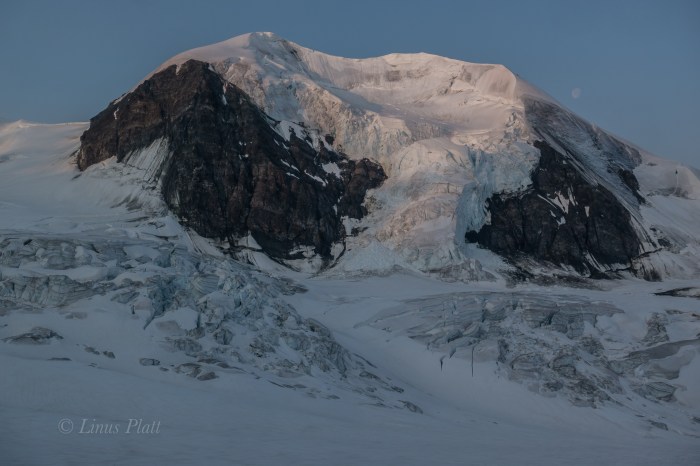



You must be logged in to post a comment.